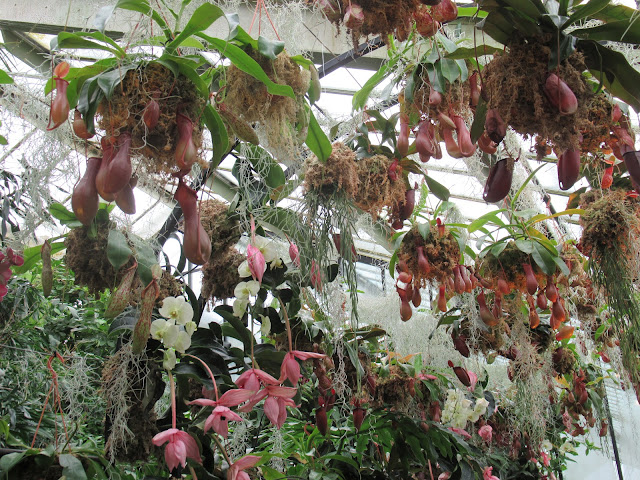My second visit to Kew Orchids this year was to take my sister there and it was a second visit that I was happy to make. In previous years, before long queues and ticketing, I would visit the exhibition several times; once in-depth and other passing visits because it was a pretty place to go.
We went for the first timed slot of the day, 10:30am, and the careful planning worked out very well. Our 65 bus arrived at Victoria Gate just after they opened at 10am and we were able to walk in via the members' queue with almost no waiting.
We ambled across to the Princess of Wales Conservatory knowing that we had half an hour to get there. Even ambling we were there in about fifteen minutes and were resigned to having to wait for another fifteen so we were very pleasantly surprised to be allowed in straight away. Not only did the remove the need for any queueing but it meant that we had forty five minutes before the next group would be allowed in.
The first big display of orchids was a series of arches in the large central section. Displays like this are best appreciated at a little distance (rather than admiring the individual flowers close-up) and that was a lot easier to do with not many people around. We were back there towards the end of our visit when it was a lot busier and there were several people patiently waiting for a gap in the crowd so that they could take the phots they wanted.
From there we took a necessarily circuitous route and tried to cover all of the main paths in all of the rooms without retracing our steps too often. Without planning, but with good knowledge of the building, I think we achieved that.
The festival seemed less intense this year with fewer staged displays and more flowers embedded in the existing beds. I liked that as I prefer the natural beauty of the individual flowers to the manufactured beauty of the displays.
As this was my sister's first visit to Kew Gardens when it was fully open (the Christmas Lights are a separate thing) we invented a route through the gardens and that worked well too. That had to start with a drink and some cake in the Orangery and from there we went to Rhododendron Dell, Minka House, Bamboo Garden, Sackler Crossing, Temperate House (mandatory) and, finally, The Pavilion to do some shopping.
It was a packed couple of hours and still left us with plenty to do on our next visit.
We went for the first timed slot of the day, 10:30am, and the careful planning worked out very well. Our 65 bus arrived at Victoria Gate just after they opened at 10am and we were able to walk in via the members' queue with almost no waiting.
We ambled across to the Princess of Wales Conservatory knowing that we had half an hour to get there. Even ambling we were there in about fifteen minutes and were resigned to having to wait for another fifteen so we were very pleasantly surprised to be allowed in straight away. Not only did the remove the need for any queueing but it meant that we had forty five minutes before the next group would be allowed in.
The first big display of orchids was a series of arches in the large central section. Displays like this are best appreciated at a little distance (rather than admiring the individual flowers close-up) and that was a lot easier to do with not many people around. We were back there towards the end of our visit when it was a lot busier and there were several people patiently waiting for a gap in the crowd so that they could take the phots they wanted.
From there we took a necessarily circuitous route and tried to cover all of the main paths in all of the rooms without retracing our steps too often. Without planning, but with good knowledge of the building, I think we achieved that.
The festival seemed less intense this year with fewer staged displays and more flowers embedded in the existing beds. I liked that as I prefer the natural beauty of the individual flowers to the manufactured beauty of the displays.
As this was my sister's first visit to Kew Gardens when it was fully open (the Christmas Lights are a separate thing) we invented a route through the gardens and that worked well too. That had to start with a drink and some cake in the Orangery and from there we went to Rhododendron Dell, Minka House, Bamboo Garden, Sackler Crossing, Temperate House (mandatory) and, finally, The Pavilion to do some shopping.
It was a packed couple of hours and still left us with plenty to do on our next visit.
























